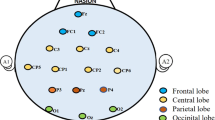Abstract
The brain computer interfaces (BCI), that are also known as brain machine interfaces or sometimes neural interface systems have a pathway of direct communication between a device and the brain. In BCI, certain devices acquire electrical signals from the brain like Electroencephalography (EEG) rhythm and further translate them in accordance to the user given commands. The acquired signals are translated by the BCI to meaningful commands. Common spatial pattern filters’ discrimination and channels’ number are incorporated for the search of the optimal channel group which is a non-deterministic polynomial (NP) problem. In this work, glow swarm optimization algorithm is used for solving the NP problem of selection of the electrodes that are optimal and that can improve the classification. Experiments were conducted for evaluating the proposed method. And the results of the experiments prove the proposed approach’s performance. The channel optimized-Naïve Bayes (NB) achieves the best classification accurateness compared to k nearest neighbor (kNN), NB and channel optimized-kNN.




Similar content being viewed by others
References
Chatterjee, A., Aggarwal, V., Ramos, A., Acharya, S., Thakor, N.V.: A brain-computer interface with vibrotactile biofeedback for haptic information. J. Neuro Eng. Rehabil. 4(1), 40 (2007)
Guger, C., Dabana, S., Sellers, E., Holzner, C.: How many people are able to control a P300-based brain–computer interface (BCI)? Neurosci. Lett. 462(1), 94–98 (2009)
Bai, V.: Classification of ECoG motor image using fusion technique. Int. J. Comput. Appl. 100(9), 6–11 (2014)
Abdulkader, S.N., Atia, A., Mostafa, M.S.M.: Brain computer interfacing: applications and challenges. Egypt. Inform. J. 16(2), 213–230 (2015)
Shan, H., Xu, H., Zhu, S., He, B.: A novel channel selection method for optimal classification in different motor imagery BCI paradigms. Bio Medical Engineering Online, BioMed Central (2015)
Polat, D.,Çataltepe, Z.: Feature selection and classification on brain computer interface (BCI) data. In: 20th Signal Processing and Communications Applications Conference (SIU), 2012 (pp. 1–4). IEEE (2012)
Zhou, Y., Zhou, G., Wang, Y., Zhao, G.: A glowworm swarm optimization algorithm based tribes. Appl. Math. 7(2L), 537–541 (2013)
Kevric, J., Subasi, A.: Comparison of signal decomposition methods in classification of EEG signals for motor-imagery BCI system. Biomed. Signal Process. Control 31, 398–406 (2017)
Noh, Y.K., Min, B.K.: Feature selection for brain-computer interface using nearest neighbor information. In: Brain-Computer Interface (BCI), International Winter Workshop on 2014 (pp. 1–3). IEEE (2014)
Ohize, H., Dlodlo, M.: Ant colony system based control channel selection scheme for guaranteed rendezvous in cognitive radio ad-hoc network. In: Personal, Indoor, and Mobile Radio Communications (PIMRC), IEEE 27th Annual International Symposium on 2016 (pp. 1–7). IEEE (2016)
Al Moubayed, N., Hasan, B.A.S., Gan, J.Q., Petrovski, A., McCall, J.: Binary-SDMOPSO and its application in channel selection for brain-computer interfaces. In: Computational Intelligence (UKCI), UK Workshop on 2010 (pp. 1–6). IEEE (2010)
Arvaneh, M., Guan, C., Ang, K.K., Quek, C.: Optimizing the channel selection and classification accuracy in EEG-based BCI. IEEE Trans. Biomed. Eng. 58(6), 1865–1873 (2011)
Dai, S., Wei, Q.: Electrode channel selection based on backtracking search optimization in motor imagery brain-computer interfaces. J. Integr. Neurosci. 16(3), 241–254 (2017)
Kee, C.Y., Ponnambalam, S.G., Loo, C.K.: Binary and multi-class motor imagery using Renyi entropy for feature extraction. Neural Comput. Appl., 1–12
Samek, W., Vidaurre, C., Müller, K.R., Kawanabe, M.: Stationary common spatial patterns for brain-computer interfacing. J. Neural Eng. 9(2), 026013 (2012)
Zhou, Y., Zhou, G., Wang, Y., Zhao, G.: A glowworm swarm optimization algorithm based tribes. Appl. Math. 7(2L), 537–541 (2013)
Xu, G., Shen, C., Liu, M., Zhang, F., Shen, W.: A user behavior prediction model based on parallel neural network and k-nearest neighbor algorithms. Cluster Comput. 20(2), 1703–1715 (2017)
Shang, F., Li, Y., Deng, X., He, D.: Android malware detection method based on naive Bayes and permission correlation algorithm. Cluster Comput., 1–12 (2017)
Ibai Díez Oronoz.: Design of classification methods for brain computer interfaces: an application using the Open ViBE software, pp. 1–124 (2015)
Author information
Authors and Affiliations
Corresponding author
Rights and permissions
About this article
Cite this article
Franklin Alex Joseph, A., Govindaraju, C. Channel selection using glow swarm optimization and its application in line of sight secure communication. Cluster Comput 22 (Suppl 5), 10801–10808 (2019). https://doi.org/10.1007/s10586-017-1177-9
Received:
Revised:
Accepted:
Published:
Issue Date:
DOI: https://doi.org/10.1007/s10586-017-1177-9




